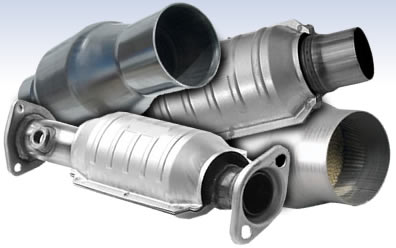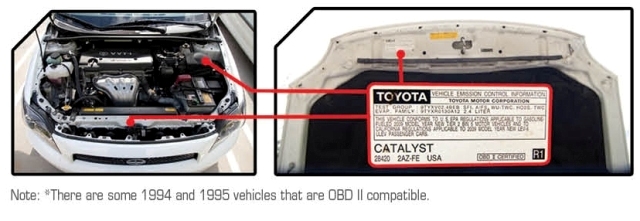Move over, California–you’ve got company when it comes to strict emissions standards.
New York, which had already adopted California’s low emission vehicle (LEV) standards in 1990, has now implemented Cali’s stricter requirements for aftermarket catalytic converters. You can read all about the requirements and rules in the New York Department of Environmental Conservation’s fact sheet.
MagnaFlow has taken this opportunity to educate you on how to choose the right catalytic converter for your on-road car or truck. The exhaust experts at MagnaFlow have even put together an easy, four-step plan to get you set up with the right converter for your OBDII (1996-newer) vehicle.
1. Select Your Application
The best way to begin your search for the right catalytic converter is by first narrowing your focus to the converters that fit your vehicle’s year, make, and model. You can use the year/make/model search on the MagnaFlow site or shop for your converter on sites, such as SummitRacing.com, that offer year/make/model search options.
2. Identify The Emissions Level
Most emissions-compliant, late-model vehicles will include a Vehicle Emissions Control Information Tag, which states your vehicle’s factory OBDII emissions certification. According to MagnaFlow, this tag is typically located in one of two spots in the engine compartment as depicted in the image below.
3. Select The Right Converter Grade
MagnaFlow recommends the use of the following catalytic converter grades, depending on your vehicle’s factory emissions certification:
- Heavy Metal Grade OBDII: For vehicles conforming to EPA (Environmental Protection Agency) Tier O and Tier 1 emissions use.
- OEM Grade OBDII: For vehicles conforming to California (CARB) TLEV, LEV, ULEV, SULEV or Federal (EPA) NLEV emissions. THIS NOW ALSO INCLUDES VEHICLES CONFORMING TO THE NEW STANDARDS FOR AFTERMARKET CATALYTIC CONVERTERS IN THE STATE OF NEW YORK.
Keep in mind, these are only guidelines from MagnaFlow, and they don’t absolve the technician of the responsibility to perform a thorough diagnosis and to install the correct catalytic converter for the application.
You can choose from three different MagnaFlow catalytic converters to meet your area’s emissions standards:
Standard Load Pre-OBDII: Designed to meet EPA emissions standards, this OBDI-compliant converter is offered in a universal-fit configuration and is available for both gasoline and diesel applications. MagnaFlow makes this catalytic converter with a traditional clam shell design as well as a more compact, spun-body design.
Heavy Metal OBDII: These OBDII-compliant catalytic converters have been upgraded to exceed EPA emissions standards and satisfy the 49-state fitment and performance requirements of early-OBDII applications. These converters provide the necessary precious metal loading to satisfy early-OBDII catalyst efficiency monitoring as well as tailpipe emissions.
OEM Grade OBDII: Engineered to meet California (CARB) emissions levels—and by extension, the latest New York requirements for catalytic converters—these premium converters feature more substrate and higher amounts of precious metals and EFN-specific wash coats to prevent false emissions codes.
4. Select the Configuration of Your Converter
Once you’ve pinpointed your converter grade, you can opt for a direct-fit or universal-fit design. A direct-fit catalytic converter will give you hassle-free, OE-like fitment tailored to your specific application. On the other hand, a universal-fit catalytic converter may require cutting, welding, or fabrication.
In addition to direct-fit and universal options, you’ll also likely come across options for traditional clam shell construction or spun-body designs. The spun-body design is basically a one-piece design in which the converter body is made from one piece of tubing and then spun into the final converter shape. This design is often more compact than the older-style clam shell construction.
Love it or hate it, emissions standards are not going away. Make sure you’re emissions-legal when it comes time to replace your catalytic converter.







[…] If the time has come to replace your catalytic, you’ll want to check out our earlier post on choosing the right catalytic converter. […]
[…] Source: https://www.onallcylinders.com/2013/04/19/magnaflow-catalytic-converters-how-to-stay-emissions-legal-… […]
Yes, this is a tough situation for myself. First time in my life, I came across a failed catalytic converter. And need a proper legal CA. Standard catalytic converter. Need guidance to find a legal one : universal and or less expensive model to replace my old failed catalytic converter. Please help me through the complicated situation and discover the best model at my price range. Thank You
Mr. Vatzug ZAdartse
You didn’t mention what kind of vehicle you have, but there are over 2,000 different catalytic converters at Summit Racing that carry CARB EO approval. While you can opt for a universal model, there’s a good chance you’ll find a direct-fit replacement for your exact vehicle/engine combo available there too.
Hi David, do you have a recommendation for a catalytic converters for a 2002 Toyota sequoia. I had a shop installed a converter and it failed after the first 6 months.
Buddy, here are some very good brands that offer converters for your vehicle: https://www.summitracing.com/search/part-type/catalytic-converters/year/2002/make/toyota/model/sequoia
Again, make sure you choose one that complies with local laws (California).
I’m struggling to find a cat converter for my f350 6.0 powerstroke diesel thats California legal. Any ideas on where i can get one?
looking a decent/cheap cat converter for my 2002 Ford F350 V1O w 3′ diameter. I live in CT. Would the Flowmaster 225 series work on this truck?
Hi there, I have a 2000 ford expedition with four catalytic converters and I’d like to reduce to two when I replace them. Can this be done and work properly?
David,
Thank you for taking the time to educate me on catalytic converters, now I need to add to the education I just received. My application will be a high performance engine installed in a 1981 vehicle, I live in California. So I guess my question would be how do you start?
How can I see catalytic converter 2006 4 cylinder 4 doors car how can I find serial number Honda Accord car
How do ya take out and put in a catalytic co on A 2010 GMC Terrain SLT 4 cylinder AllWheel Drive, But my Ins says my vin number says differ says 4 wheel Dr, It make a different on removing the converter?
I have just a few questions first I have a 1984 Porsche 928 that I drive less than 100 miles a year and it has the same catalytic converter that came when new and it has never failed a smog check in CA. My question is I am thinking about upgrading to 2 converters and 2.5″ tubing all the way back and I would think that 2 New converters would do a better job cleaning the air compared to a 39-year-old single unit. I was unaware that all the states boarding next to California that the smog stops at their boarder and does not enter those states. I can buy 2 converters for less than $300.00 along with all the 2.5″ tubing going all the way back than 1-California converter that is almost $1,600.00 just for the converter now what is wrong with this picture? It is also kind-a funny that when I ask how old the car needs to be before it does not require a smog test I always get a different answer maybe you can tell me when I will no longer require the test? I also have a 1971 Datsun 240Z that I bought new while stationed overseas and also a 1970 EL Camino with a 350 and they do not require smog.
Thank you for your time!